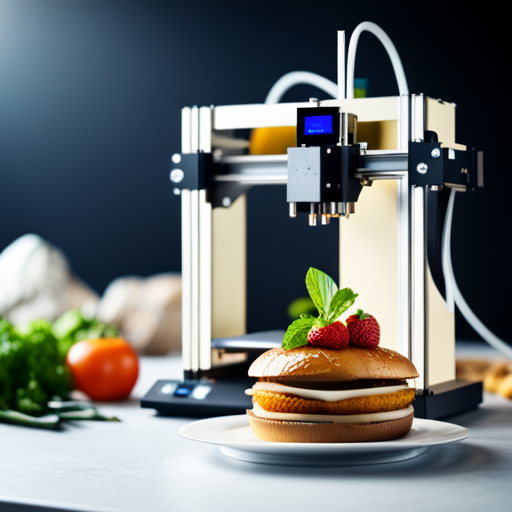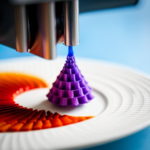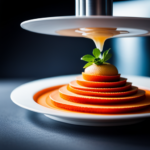In a world where dietary restrictions and allergies often dictate meal choices, the emergence of food 3D printing offers a promising solution. With the ability to customize meals to fit specific diets and allergies, this technology has the potential to revolutionize the way we approach food consumption.
From nutrient-dense creations to overcoming the challenges of special diets, the implications of 3D printed food are vast. Join us as we explore the benefits and future possibilities of food 3D printing for special diets and allergies.
Benefits of Food 3D Printing for Special Diets
Food 3D printing offers precise and customizable solutions for individuals with special dietary needs, enabling the creation of tailored meals that adhere to specific nutritional requirements and restrictions. This personalized nutrition approach is a game-changer for those with allergies, intolerances, or specific dietary needs.
Culinary innovation is at the forefront of this technology, allowing for the transformation of basic ingredients into intricate, customized dishes that cater to individual needs.
Personalized nutrition is a key benefit of food 3D printing, as it allows for the precise control of ingredients, ensuring that individuals receive the necessary nutrients while avoiding allergens or intolerances. This level of customization is unparalleled in traditional food preparation methods, making food 3D printing a revolutionary option for those with special dietary requirements.
Moreover, food 3D printing represents a significant leap in culinary innovation, pushing the boundaries of what is possible in food creation. The technology enables the precise layering of ingredients, leading to the development of unique textures, flavors, and presentations that are tailored to an individual’s needs. This not only enhances the dining experience but also opens up new possibilities for creating visually stunning and delicious meals.
Customization for Allergies and Dietary Restrictions
When addressing the customization for allergies and dietary restrictions in the context of food 3D printing, it is essential to emphasize the precise control and management of ingredients to accommodate individual nutritional needs and avoid allergens or intolerances.
Food 3D printing offers the potential for personalized options that cater to specific dietary requirements. This technology allows for the creation of allergy-friendly designs, ensuring that individuals with food allergies or intolerances can enjoy safe and tailored food products.
By utilizing 3D printing, it becomes feasible to exclude specific allergens or incorporate alternative ingredients while maintaining the desired taste, texture, and nutritional content. For instance, individuals with gluten intolerance can benefit from the production of gluten-free food items that are customized to their preferences.
Moreover, food 3D printing enables the development of specialized products for individuals with conditions such as celiac disease, nut allergies, lactose intolerance, and other dietary restrictions.
The ability to customize food through 3D printing represents a significant advancement in addressing the diverse needs of consumers with specific dietary requirements.
Nutrient-Dense 3D Printed Meals
The development of nutrient-dense 3D printed meals is revolutionizing the provision of specialized dietary options. These meals are not only tailored to meet specific dietary requirements but also focus on flavor innovation and the use of sustainable ingredients. Culinary creativity is at the forefront of this innovation, as chefs and nutritionists collaborate to ensure that these meals are not only nutrient-dense but also visually appealing.
| Nutrient-Dense 3D Printed Meals | ||
|---|---|---|
| Meal Components | Nutrient Content | Sustainable Ingredients |
| Protein | High-quality protein sources | Plant-based proteins |
| Carbohydrates | Slow-digesting carbs | Whole grains, legumes |
| Fats | Healthy fats | Nuts, seeds, avocados |
| Vitamins and Minerals | Wide variety | Fresh fruits and vegetables |
| Flavor Enhancers | Natural herbs and spices | Locally sourced flavorings |
This approach to food production not only meets the nutritional needs of individuals but also contributes to sustainable food practices. By incorporating nutrient-dense and sustainable ingredients into 3D printed meals, this culinary innovation is paving the way for a healthier and more environmentally conscious future.
Overcoming Challenges With Special Diets
Addressing the unique dietary requirements of individuals can pose significant challenges, particularly for those with special diets or allergies. These challenges often stem from the need to adhere to specific dietary restrictions while ensuring adequate nutrition and variety in meals.
One solution to overcoming these challenges is through innovative customization, such as 3D printing of food. By harnessing this technology, it becomes possible to tailor meals to meet the precise dietary needs of individuals, including those with allergies or special dietary requirements. 3D printing allows for the precise control of ingredients, portion sizes, and nutritional content, enabling the creation of personalized meals that align with specific dietary restrictions.
This level of customization can revolutionize the way individuals with special diets or allergies approach food consumption, offering them a broader range of meal options while ensuring their nutritional needs are met.
Additionally, leveraging 3D printing technology in food production can streamline the process of creating meals that cater to diverse dietary requirements, ultimately enhancing the overall dining experience for individuals with special diets.
Future Implications of 3D Printed Food
Leveraging 3D printing technology in food production can offer a multitude of future implications for individuals with special dietary needs or allergies, allowing for precise customization and expanded meal options. One significant implication is the potential for enhanced sustainability in food production. 3D printing can optimize ingredient use, reduce food waste, and enable the creation of nutritious and appetizing meals tailored to specific dietary requirements. This could lead to a more efficient and sustainable food industry, addressing environmental concerns and promoting ethical food practices.
Ethical considerations also come into play with the future implications of 3D printed food. As the technology advances, questions regarding the sourcing of ingredients, fair labor practices, and the impact on traditional food production methods will need to be addressed. Ensuring that 3D printed food aligns with ethical standards, such as fair trade and sustainable sourcing, will be crucial for its acceptance and long-term success.
Additionally, maintaining transparency about the nutritional content and origin of 3D printed food will be essential for consumer trust. As this technology evolves, it will be imperative to navigate these ethical considerations to create a food system that is both innovative and responsible.
Frequently Asked Questions
How Does Food 3D Printing Technology Handle Cross-Contamination for People With Severe Allergies?
Cross-contamination management is crucial for individuals with severe allergies. Quality control processes in food 3D printing technology are designed to prevent cross-contamination, ensuring the safety of those with allergies by carefully monitoring and controlling production processes.
Are There Any Limitations to the Types of Foods That Can Be 3D Printed for Special Diets?
Food safety is paramount in 3D food printing. Ingredient compatibility and texture play a crucial role in determining the types of foods suitable for printing. While numerous foods can be printed, limitations exist in achieving specific dietary requirements.
Can Food 3D Printing Technology Accommodate Religious Dietary Restrictions, Such as Kosher or Halal?
Cultural considerations play a crucial role in 3D printing, especially when accommodating religious dietary restrictions such as kosher or halal. Advanced 3D printing technology can potentially address these needs, offering tailored food solutions.
What Are the Potential Cost Implications for Using 3D Printed Food for Special Diets and Allergies?
Assessing the potential cost implications of 3D printed food for special diets and allergies entails meticulous cost analysis, scrutiny of food safety concerns, and addressing accessibility issues. These challenges necessitate thorough examination for effective implementation.
Are There Any Ethical Considerations Related to Using 3D Printed Food for Individuals With Special Dietary Needs?
Ethical considerations are paramount when assessing 3D printing safety for food technology and addressing dietary restrictions. The use of 3D printed food for individuals with special dietary needs must prioritize safety, nutritional value, and respect for cultural and personal food choices.
Conclusion
In conclusion, food 3D printing offers numerous benefits for individuals with special diets and dietary restrictions. This includes customization for allergies and the ability to create nutrient-dense meals.
While challenges do exist, such as taste and texture, ongoing research and technological advancements are addressing these issues.
The future implications of 3D printed food are promising, with the potential to revolutionize the way we approach special diets and allergies.
Further investigation into the efficacy and long-term effects of 3D printed food will provide valuable insights for its widespread adoption.


